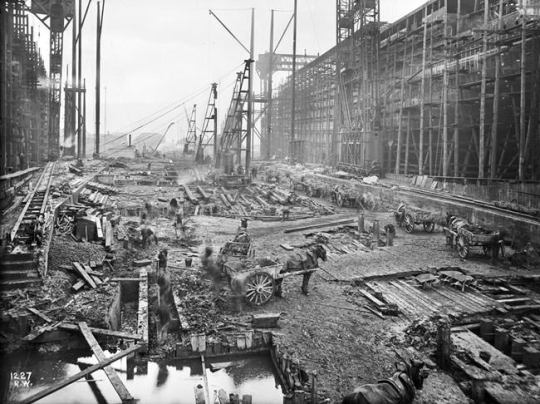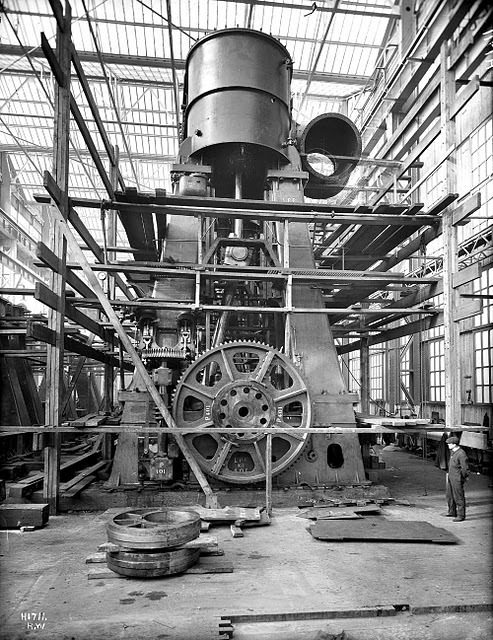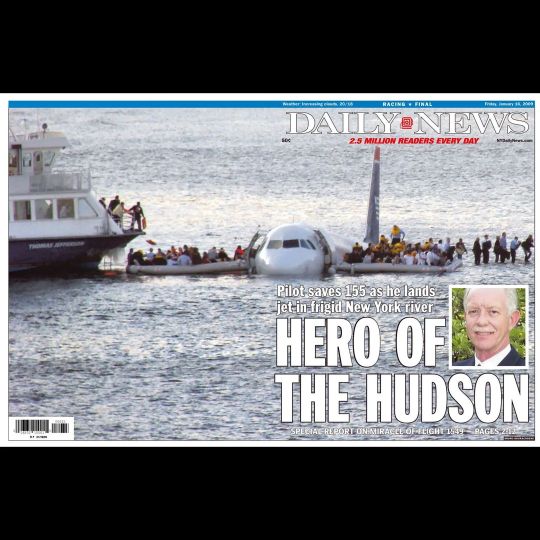#transportationhistory
Text




Building the Unsinkable The Story of the Titanic's Construction and Rise to Fame
#Titanic#shipbuilding#maritimehistory#oceanliners#history#vintagephotography#historicallandmarks#shipwrecks#tragedy#engineering#transportationhistory#luxurytravel
4 notes
·
View notes
Photo

On This Day in New York City History February 5, 1952: New York City announces that it will adopt the three-light traffic signal. The patent for the three-position signal belongs to African-American inventor Garrett Morgan who received said patent in 1923.
The patent filed on February 27, 1922 (and granted on November 20, 1923 as patent number 1,475,074) improved on the already in use two position "stop (red) and go (green)" traffic signals by adding a third "warning" position signal to alert drivers that the signal would change from go to stop and vice versa. On doing so, drivers could proceed with caution and helped to reduce the amount of accidents that occurred during the signal changes.
Morgan would eventually sell the invention to General Electric for $40,000 dollars.
#GarettMorgan #ThreePositionTrafficSignal #InventorHistory #TransportationHistory #BlackHistory #BlackStudies #BlackHistoryMatters #AfricanAmericanHistory #AfricanAmericanStudies #NewYorkHistory #NYHistory #NYCHistory #History #Historia #Histoire #Geschichte #HistorySisco
https://www.instagram.com/p/CoSsXQtu8dZ/?igshid=NGJjMDIxMWI=
#Garrett Morgan#Three Position Traffic Signal#Inventor History#Transportation History#Black History#Black Studies#Black History Matters#African American History#African American Studies#New York History#NY History#NYC History#History#Historia#Histoire#Geschichte#HistorySisco
13 notes
·
View notes
Photo

Dunbar Covered Bridge
I stumbled across this bridge recently while poking around the Big Four/NYC line west of Indianapolis. Built in 1880, it seems to be in good shape. It can be found just northwest of Greencastle, Indiana.
One image by Richard Koenig; taken March 6th 2021.
#transportationhistory#dunbarcoveredbridge#dunbar#coveredbridge#greencastleindiana#greencastle#indiana
25 notes
·
View notes
Photo

Having my fun sitting in a Model T Ford at the Forney Museum of Transportation in Denver. 🚃 ✦ Normally, I wouldn’t be a transportation history buff, but sweet heavens was this an interesting place! ✦ This museum is packed with some of the most rare pieces of trains, planes, and vehicles in history. ✦ SO worth a visit! 🎟 •••••••••••••••••••••••••••••••••••••••••••••••••• 📍Forney Museum of Transportation •••••••••••••••••••••••••••••••••••••••••••••••••• #forneymuseum #forneymuseumoftransportation #publictransportation #transportationhistory #historicpreservation #denver #thingstodoindenver #visitcolorado #travelcolorado #modeltford #modelt #ford #coloradotraveltips #coloradoblog #coloradotravelblogger #travelblogger (at Forney Museum of Transportation) https://www.instagram.com/p/BwR8kFblVFI/?utm_source=ig_tumblr_share&igshid=nyvbst57jgjm
#forneymuseum#forneymuseumoftransportation#publictransportation#transportationhistory#historicpreservation#denver#thingstodoindenver#visitcolorado#travelcolorado#modeltford#modelt#ford#coloradotraveltips#coloradoblog#coloradotravelblogger#travelblogger
0 notes
Photo



City of Seattle Planning Commission. (1957) Planning for Thoroughfares: Empire Expressway I. Seattle, WA: City of Seattle.
This 1957 report published by the City of Seattle’s Planning Commission laid out plans for an additional north-south freeway through Seattle. The Empire Expressway would develop a thoroughfare from the International District in the south all the way to Bothell Way in the north. This plan was part of a mass movement towards highway building and transportation via personal vehicle that swept the United States during the 1950’s and 1960’s. This document is vital to understanding the Seattle Freeway Revolt, where ordinary citizens fought their city government tooth and nail to prevent this highway from being completed, arguing that it would destroy their neighborhoods and effectively damage the very fabric and character of Seattle. The color map shows at least four major north-south thoroughfares planned through Seattle.
1 note
·
View note
Link
Subscribe for Daily Updates. TODAYINCTHISTORY.com
0 notes
Photo

Check out these two photographs of the same event taken from opposite angles. Placed together, they really create a more complete picture of the train accident of September 11, 1905. (photos via @brooklynhistory and @nypl)⠀ .⠀ At a few minutes after 7 a.m., a downtown-bound train on the Ninth Avenue El plunged from the tracks at the corner of 53rd Street, ultimately killing 13 and injuring 48, in what was then the worst subway accident in city history. ⠀ .⠀ The wreck occurred at the point where downtown-bound Ninth and Sixth Avenue tracks diverged, with Sixth Avenue trains making a 90 degree turn East along 53rd Street. Ordinarily, the approaching downtown train would display a placard indicating to the towerman whether to activate the switch for the curve. In this case a miscommunication between the motorman and the towerman (who may not have been at his post) sent the train into the curve at more than three times its speed limit. The motorman braked, but was unable to prevent two cars from careening over the edge of the trestle. One car slammed into the ground while the other came to rest partially suspended by the second floor window of no. 798 Ninth Avenue. The New York Times described the scene:⠀ .⠀ “The third car of the train, hurled forward by the weight of those behind it, was shoved over the elevated structure and its forward end was forced through the window of the apartment of Mrs. James G. Crowe, who lives above the drug store. The car rocked for a moment and seemed as if about to fall into the street. Then it settled, its forward end held by the sill of the window and the fire escape, and hung suspended like a bridge across the street. The frantic passengers clambered out of the windows and along the roof into the apartments of Mrs. Crowe, and thence to the street.”⠀ .⠀ .⠀ 📸 #1: Eugene Armbruster/ 1905/@brooklynhistory⠀ 📸 #2: Gustave Scholer/ 1905/@nypl⠀ #urbanarchive #nychistory #hellskitchen #trainaccident #transittuesday #transportationhistory #elevatedtrail ⠀ Join the Urban Archive beta 📱 [link in bio] via ✨ @padgram ✨(http://dl.padgram.com) https://www.instagram.com/p/BelIv0InGdN/
7 notes
·
View notes
Photo

Meet Stanley, the driverless car. In 2004, a team at Stanford University and Volkswagen’s Electronics Research Laboratory collaborated to create this driverless car, which they nicknamed “Stanley.” 🚗 Its driverless decision making is enabled through sophisticated programs in onboard computers. The vehicle decides how to navigate mapped terrain and unmapped obstacles in real time—using information from a course map, stored memory of past experiences, and new information about the road ahead gathered from roof-mounted laser sensors, video cameras, radar, and GPS receivers. 🏆 In 2005, Stanley beat 22 other robot cars in a 132-mile race in the desert near Las Vegas, Nevada. The goal of the race, sponsored by the Defense Advanced Research Projects Agency (DARPA), was to stimulate invention for a future fleet of driverless military ground vehicles. #RobotWeek #NationalRobotWeek #Robotics #AmericanHistory #TransportationHistory #MilitaryHistory #CarHistory https://ift.tt/2GSPAwg
0 notes
Photo

On This Day in New York City History January 15, 2009: Dubbed "The Miracle on the Hudson" Passenger jet US Airways Airbus A320, Flight number 1549 piloted by Captain Chelsey B. Sullenberger III and co-pilot Jeff Skiles execute a ditch landing on the Hudson River.
The plane bound for Charlotte, North Carolina lost both engines due to contact with a flock of geese minutes after taking off from LaGuardia Airport. Captain Sullenberger's quick thinking and nerves of steel in piloting the powerless jet ensured that all 155 people on board were safe.
#MiracleOnTheHudson #CaptainChelseySullenbergerIII #CaptainSully #CaptainJeffSkiles #USAirways #AviationHistory #TransportationHistory #NewYorkHistory #NYHistory #NYCHistory #History #Historia #Histoire #Geschichte #HistorySisco
(at Hudson River, New York)
https://www.instagram.com/p/CncyDatOpSV/?igshid=NGJjMDIxMWI=
#Miracle on the Hudson#Captain Chelsey Sullenberger III#Captain Sully#Captain Jeff Skiles#U.S. Airways#Aviation History#Transportation History#New York History#NY History#NYC History#History#Historia#Histoire#Geschichte#HistorySisco
11 notes
·
View notes
Text


On This Day in New York City History March 24, 1900: The ground was broken by NYC Mayor Robert Anderson Van Wyck at City Hall for NYC's first subway called the Interborough Rapid Transit line (IRT). Established by Rapid Transit Act of 1894, the contract known as "Contract One", started operating the first underground line on October 27, 1904 and was managed by financier August Belmont.
The initial IRT line started at City Hall and followed the current 4-5-6 train local route to 42nd Street. It would then turn west on 42nd and continue north under Broadway on the current 1 train route to 145th Street.
Service into Brooklyn would come with "Contract Two" of 1902 with stops at Borough Hall, Hoyt Street Nevins, Nevins Street and Atlantic Avenue.. our of the original stations City Hall, Worth Street, 18th Street and 91st Street have been closed.
#NYCSubway #InterboroughRapidTransit #IRT #RobertAndersonVanWyck #AugustBelmont #SubwayHistory #MassTransitHistory #TransportationHistory #TrainHistory #NewYorkHistory #NYHistory #NYCHistory #History #Historia #Histoire #Geschichte #HistorySisco
#NYC Subway#Interborough Rapid Transit#IRT#Robert Anderson Van Wyck#August Belmont#Subway History#Mass Transit History#Transportation History#Train History#New York History#NY History#NYC History#History#Historia#Histoire#Geschichte#HistorySisco
4 notes
·
View notes
Photo



Joseph L. Block Arrives Duluth
This ship was built in 1976 and is 728 feet in length. I believe it has come to Duluth with a load of limestone to be discharged at Hallett Dock Number 5.
Three images by Richard Koenig; taken July 23rd 2017.
60 notes
·
View notes
Photo





Duluth Entry
One-thousand feet in length, American Integrity is seen entering Duluth Harbor under the iconic Aerial Bridge. I believe she has been shuttling between Superior, Wisconsin, and Detroit, Michigan, with coal for DTE.
The ship was built in Sturgeon Bay, Wisconsin, and has been sailing for just over 39 years—though with several names over that time frame.
Five photographs by Richard Koenig; taken July 19th 2017.
34 notes
·
View notes
Photo





The Ironton Ferry
Recently I was able to travel aboard a vessel called the Charlevoix—this is the Ironton Ferry, found in the lower peninsula of Michigan. It carries persons, automobiles, and bicyclists across the South Arm of Lake Charlevoix.
According to a pamphlet given to me by Captain Bob Goodenough, the ferry has been in operation since 1883 and the current vessel has been around since 1925. The crossing covers a distance of 610 feet and is secured by cables.
The town of Ironton does have a relationship to that metallic element—the Pine Lake Iron Company opened shop here in 1881. It turned ore from further north into pig-iron; it failed in the late 19th century. A steel mill can still be found nearby however—the East Jordan Iron Works, founded in 1883. It operates today at the end of the South Arm, in the town of East Jordan.
Five images by Richard Koenig; taken August 10th and 11th of 2017.
14 notes
·
View notes
Photo




Two Ships, Passing
A laker, the Cason J. Callaway, has departed Duluth while a pontoon plane flies overhead. The ship is headed for Two Harbors, about twenty miles up the north shore. Another ship, the American Spirit, soon comes into view. She is headed for Duluth as light fades.
The former was built in 1952 and is 767 feet in length, while the latter is one of the larger ships—it was built in 1978 and is 1,004 feet in length.
Four images by Richard Koenig; taken July 23rd 2017.
27 notes
·
View notes
Photo

Frontenac
This ship is seen moving toward the Aerial Bridge, Duluth, on a warm and muggy day in the Northland. This Canadian ship is 730 feet long and was first launched in December of 1967—making it nearly fifty years old.
One photograph by Richard Koenig; taken July 20th 2017.
10 notes
·
View notes
Photo





The Frontenac Arrives Duluth
This ship is a classic “laker” design (having the bridge on the bow rather than astern) and is nearly fifty years old (built in 1968). The Frontenac (Canada) has arrived at Duluth to pick up taconite pellets that are likely destined for steel mills in northern Indiana. It is headed through the Duluth entry canal and will soon pass under the iconic Aerial Bridge.
The spring can be quite foggy near the lake as the surrounding hills warm but the lake retains its cool temperature. These five images were made by Richard Koenig in the late morning of April 16th 2017.
59 notes
·
View notes